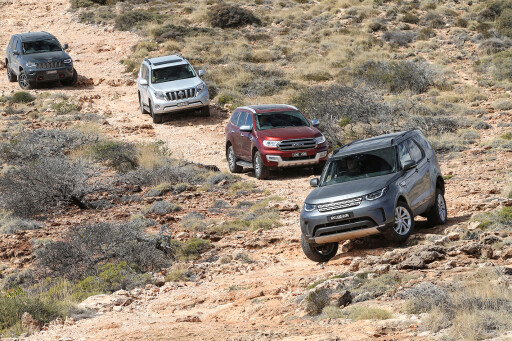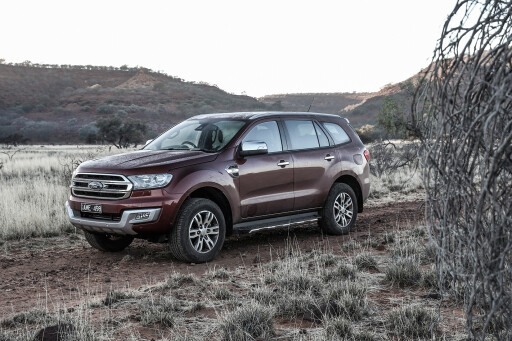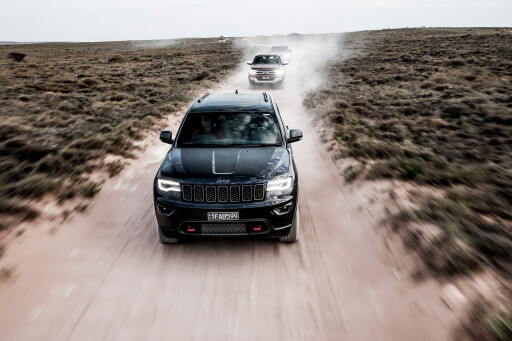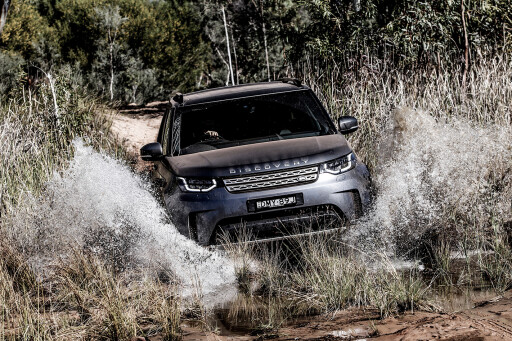
AUSTRALIA may be a land of vast expanses and remote, unforgiving country, but when it comes to exploring this wide, brown land it is Japan we’ve typically turned to for off-road transport.
Far from the neon high-rise wilds of Tokyo and its surrounds comes the Toyota Land Cruiser, Nissan Patrol and Mitsubishi Pajero, which have been staples of outback life. Not that the nation that settled in Australia more than 200 years ago is silent on the matter of four-by-fours that get the job done. Since the early 1990s the Discovery has been a mainstay of the Land Rover line-up and a car that has appealed to families and adventurers alike.

For the latest Discovery the boxy styling has gone, replaced by a softer look with Range Rover-esque curves. But is the all-new Discovery soft underneath, or is it fifth time lucky for Land Rover’s quintessential family off-roader? To determine its fate we’ve assembled a trio of intercontinental rivals and a few thousand kays of remote and punishing West Australian roads. The Discovery straddles the luxury and off-road segments, something we’re putting to the ultimate test in this showdown.
Our chosen ride has the Sd4 engine, the more powerful of the two 2.0-litre diesel units. From Ford is the flagship Everest Titanium riding on a new 18-inch wheel-and-tyre package. Its most direct rival is the Toyota Prado, joining us here in top-of-the-range Kakadu trim. And it’s a left-fielder from Jeep in the form of the most capable Grand Cherokee, the newly minted Trailhawk.
FORD EVEREST TITANIUM
IF Wikipedia had a page dedicated to 4x4 success stories, the Ford Ranger ute would surely be somewhere near the headline. Accounting for more than half of Ford Australia’s sales, the stylish and capable ute has changed the dynamic of the booming dual-cab market. Its wagon offshoot, the Everest, has been less successful, in part because it goes up against the might of the Prado, a car that slots neatly beneath the Land Cruiser and nails the off-road brief.
Not that the Everest has anything holding it back. Its basic mechanical package is shared with the Ranger, right down to the grunty 3.2-litre five-cylinder. It doesn’t take long behind the wheel, though, to notice substantial differences. Active noise cancelling (using a trio of microphones in the roof) quietens the engine; although, it’s still the most vocal of this bunch. Compared with the Jeep and Land Rover, the Everest is almost raucous; you know when it’s working. Still, the power delivery is near instant, arguably the best of the lot, a result of careful throttle tuning that gives the impression it’s dishing out more than the 143kW and 470Nm in the brochure.
 That immediate and predictable throttle response makes for easy going off-road, especially when clambering over rocks or slushing through sand. No waiting for turbos to spool in this baby. Yet while it’s a stout performer, it’s honest rather than exciting, and that’s not helped by its near 2.5-tonne heft, something that also hurts fuel consumption. On our test it used 11.3L/100km, a fraction less than the Prado, but enough to make the Everest’s modest 80-litre tank the one we needed to feed first. Regular refuelling aside, the further you go in the Everest the more it grows on you.
That immediate and predictable throttle response makes for easy going off-road, especially when clambering over rocks or slushing through sand. No waiting for turbos to spool in this baby. Yet while it’s a stout performer, it’s honest rather than exciting, and that’s not helped by its near 2.5-tonne heft, something that also hurts fuel consumption. On our test it used 11.3L/100km, a fraction less than the Prado, but enough to make the Everest’s modest 80-litre tank the one we needed to feed first. Regular refuelling aside, the further you go in the Everest the more it grows on you.
As with all ute-based SUVs the rear suspension is a more sophisticated coil-spring setup, something that ties the Everest down nicely. The extensive local development undertaken by Ford engineers shines on myriad surfaces, as the Everest copes beautifully with big hits while also smoothing the thrum of corrugations. There’s a settled and consistent nature to it.
Our Titanium was fitted with the recently arrived 18-inch wheel and tyre package. Instead of the 20s formerly fitted exclusively to the Titanium, it gets the option of 18s from the mid-spec Trend, something teamed with revised springs and dampers to ensure it is optimised to the rubber. However, it was the only one of our quartet not running All Terrains, which is less than ideal for a trip like this, albeit something easily solved from the aftermarket.
Even so, the extra air between the rim and the road dishes up compliance while allowing more sidewall flex to (hopefully) ward off punctures.
Our drive consisted of plenty of sharp rocks, high speed gravel and sand, and the Everest’s Bridgestone Duelers never faltered. Indeed, the Everest’s easy-going nature continues in rugged terrain. The traction control is nicely tailored, ensuring effortless progress, even without a locking centre diff (only the rear locks). However, it’s a shame the Terrain Management System – which adjusts throttle, traction control and braking – doesn’t allow Rock mode until you select low range.
Then there’s the price. At $74,701 the Titanium is a big whack for a car with lots of grey plastics that don’t do a lot to justify the price. The list of standard gear is also thin, doing without things such as smart-key entry or auto braking (the latter available on all three rivals). And, while it’s a sizeable (and heavy) machine, the Everest doesn’t have the interior space of the Prado.
Middle row headroom, for example, is only average for tall adults, and the 25mm it gives away on width to the Prado makes for a narrower cabin. So, it’s a car oozing driving appeal, but one that trips in some key areas.
JEEP GRAND CHEROKEE TRAILHAWK
AS A strict five-seater, and with the shortest body by at least 64mm, the Trailhawk won’t be on every consideration list from the get-go. However, the most off-road-capable version of the Grand Cherokee strikes a chord for smaller families and couples looking for a tourer that favours luxury over interior space.
At $74,000 it’s loaded with kit including leather and suede, and it also comes with a tantalising sales pitch among this quartet: more power. The 3.0-litre V6 twin turbo-diesel musters 184kW and 570Nm. Weave it through the standard eight-speed auto and it makes for a lively companion, albeit one that calls for careful attenuation of the throttle – hints of turbo lag and a less direct correlation between what your right foot is demanding and what ends up happening can make for jerky progress. Easing over something bumpy or technical demands careful prods of the throttle. With the cruise control dialled up, though, it’s a comfy and effortless companion; its above-average on-road manners shining.

The air suspension is a mixed bag. Without much weight on board it delivers a nice blend of control and comfort, but throw corrugations or washouts into the mix with some weight out back and things deteriorate. It lacks the control and elegance to cope as well as its rivals with the high-speed outback roads Australia does so well. It’s also less convincing the more weight you pile into it. For example, the rear end can be left purpoising as the dampers try to contain things.
But the Trailhawk’s reason for being is solid, serious off-roading, a role it slots into eloquently. Dial-up the highest of its two off-road heights and the air suspension leaves 260mm between the beefed-up underbody protection and rocks. And, being based on a previous generation Mercedes-Benz ML (remember when Jeep and Chrysler were part of the Daimler family?), it not only gets an independent front-end – as with its three rivals here – but matches the Disco with an independent rear.
Articulation is modest, though, even with the additional droop of the air springs; it doesn’t take much in the way of undulations to kick a wheel in the air as the travel reaches its limits. Thankfully the Quadra-Drive II 4WD system does a beautiful job of apportioning drive.
It pays to muck around with the Off-Road pages included in the central touchscreen, to understand when the rear diff is locking and what’s going on with those mechanicals. The air suspension, in particular, is sometimes too eager to automatically lower, often when you really don’t want it to. Even with one or two wheels dangling, the Grand Cherokee motors on until all four get stuck.
Dig deeper, though, and the off-road promise is partly laced in marketing icing rather than engineering meat, at least in some key areas. The spare tyre, for example, is a Kumho without the Kevlar-reinforced puncture resistance of the four Goodyears. It’s also a different size, just 245mm wide versus the quart-et of 265s. And the flashy red tow hooks on the nose aren’t matched by a tow point of any sort at the rear. That alone is one reason a tow bar would be a worthy option, at least giving some sort of hitch point to be towed from strife. The Trailhawk excels on towing duties, able to lug 3500kg, and you get the impression its 3.0-litre wouldn’t have an issue with a load out back.
Despite being by far the smallest car here – and the only five-seater – the Grand Cherokee is the only car with a V6, something that makes it the most powerful of our quartet, with 184kW. Its stout 570Nm, too, is handy, especially on the open road; the Jeep is rarely lacking in thrust. Despite its grunt there’s decent touring range courtesy of relative economy – we used 10.7L/100km – and a 93-litre tank.
LAND ROVER DISCOVERY SD4 HSE
STEPPING into the Discovery is like teleporting into a car from another class. With more than a few hints of Range Rover – such as the digital instrument cluster and immaculate trimming – the Disco is in another league for cabin ambience.
Storage, too, is brilliant, from the twingloveboxes to the handy hidey hole behind the ventilation controls, one of many odds-and-ends binnacles that house everything from maps to the activity key that is like a swimming-friendly fitness band.

You pay for the privilege, though. Our HSE Sd4 starts at $93,550 ($3400 more if you want an extra row of seats). Sure, you could opt for an S (with cloth trim and coil spring suspension) or SE with the same mechanical package, but with each step down you’re deleting some of that luxury fare.
There’s even plenty left on the extensive options list for the luxurious HSE: any colour other than white, tyre pressure monitors, digital radio, heated seats, adaptive cruise control... Sure, the basics are right, but to get that real luxury feeling you’re into six figures. For a big spend you get a big body. There’s impressive width to the cabin and, while it’s arbitrary for a trip like this, the third row of seats is the only one here that can comfortably seat adults.
The attention to detail is more than skin deep, starting with the new Ingenium engine. With 177kW and the Disco’s aluminium-intensive body, it makes for a willing combination. Its performance is impressive, building pace effortlessly when called on, in turn relying on its hearty 500Nm that arrives way down at 1500rpm. Teamed with supple air suspension it’s a fine way to travel in style and also in total comfort.
Plus, it’s impeccably smooth and refined, the intuitive eight-speed auto adding to its luxury credentials. The HSE we’ve chosen here comes shod in 20-inch rubber, which works beautifully on the road. Compared with its competition the Discovery feels borderline sporty, at least as much as a 2.2-tonne off-roader can. Cementing the high tech drivetrain injection is fuel economy we’ve not experienced in something this size.
Claimed consumption is just 6.5L/100km and, while you’re unlikely to get that in the real world – we averaged 9.9L/100km across a range of terrain – it still makes the compact 77-litre more useful than you may expect.
Off-road, though, is where the core engineering shines, but only if you tick more option boxes – the Terrain Response system is optional, for example. At least the HSE gets adjustable height air suspension and a dual-range transfer case, two things you pay extra for on the S model. On its highest level that air set-up delivers a towering 283mm of clearance and, despite independent suspension front and rear, there’s monstrous articulation that does a brilliant job keeping rubber on the track.
The Disco can also ford 900mm of water and has excellent approach and departure angles, something that ensured effortless progress across rocks and occasionally rutted tracks. The optional rear e-diff – which lock electronically as required – also does a brilliant job in sand (there was plenty) and other low grip situations. The high tech set-up doesn’t open itself to aftermarket upgrades as much as something with coil springs and mechanical diffs, but for a package out of the box it’s beautifully sorted.
There are foibles, though, starting with the recovery points. It seems Land Rover either isn’t expecting it to get stuck or isn’t expecting its owners to muddy the tyres. The front tow hooks are hidden beneath the plastic styling panel forward of the proper sump guard, and the owner’s manual recommends removing the garnish before going off-road. The sizeable 20-inch rubber sparked heated campfire discussions about their suitability to Aussie terrain.
Land Rover’s large hoops have traditionally fared poorly, but on this occasion – and across a broad and punishing selection of surfaces – the Disco emerged without a puncture. At times we were running 20psi or less, something that allowed sufficient bagging of the tyres for added traction.
TOYOTA PRADO KAKADU
FOR a car that was largely untouched for years since its 2009 arrival, the 150 Series Toyota Prado has undergone a recent transformation.
A new generation 2.8-litre engine arrived on the scene in 2015 and, as we were washing the red dirt out of our clothes from this trip, Toyota announced an update that’s recently arrived in dealerships. Revised bumpers and a 200 Series-esque bonnet are the headline visual changes, while Toyota’s latest active safety features were added for good measure. None of which impacts how the soon-to-arrive Prado drives – the suspension is unchanged, as is the drivetrain.
Given our deadlines and its significance to the 4x4 scene, we decided it was worth getting the outgoing Prado along for the ride. And while we’ve typically gone for the rough-and-ready GXL, for this test it’s the Kakadu gracing the WA outback, complete with airbag self-levelling rear suspension and KDSS sway bars to better control the body through bends.

It’s the no-nonsense design of the Prado that shines, and the tow hooks are a prime example. There are no lairy colours or clips and screws; just a sizeable tow point at either end, ready for business. Unfortunately, that simplicity continues through to the engine, which is honest but uninspiring. The 2.8-litre four-cylinder manages just 130kW and a more respectable 450Nm, which arrives from just 1600rpm to make it a handy performer on initial throttle applications. There’s no zing or excitement, though, and the more pace you build the harder you have to work it; make sure you have a decent run up for overtaking road trains.
None of this affects its performance off-road, as the engine is, after all, better suited to grunt work – which is where the Prado starts to win back points. There’s solidity to its construction that comes through every time you thunder into a washout or over a craggy cattle grid.
Great articulation and a well-tuned traction control system also help; plus there’s a locking centre and rear diff for when things get sticky. It’s a shame Toyota’s MTS (multi-terrain select) system dominates so much of the dash with its plastic dial (it gets a welcome refresh with the new model) that delivers so little.
All it does is alter the level of slip allowed by the traction control; the sand setting, for example, allowing more wheelspin. It’s the self-levelling rear end and adjustable sway bars, part of the KDSS system, which give the Prado its biggest leg up. Fully laden, Prados can drag their rumps over peaky obstacles, something the Kakadu solves nicely.
The added body control of the KDSS system makes for less rocking from side to side, making the Prado a far more pleasant thing to punt along trails at 30 or 40km/h.
One negative with the Prado generally, and the Kakadu more specifically, is how much you can carry. The 2990kg GVM limits people and luggage to 545kg, something you can easily reach with a few days’ camping supplies and a family with their gear. At least you don’t need to worry about carrying extra fuel, as the Prado’s 150-litre capacity means that even when laden it’ll comfortably cover more than 1000km.
Plus, the Kakadu comes loaded with fruit, including heated front- and second-row seats, a fold-down rear screen to keep back-seaters content, and a deep cooler box that keeps drinks and snacks chilled.

COMMENTS